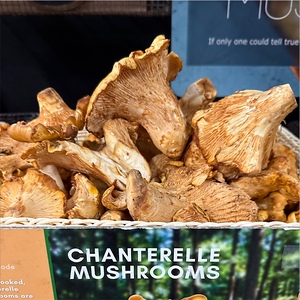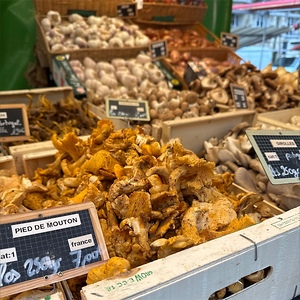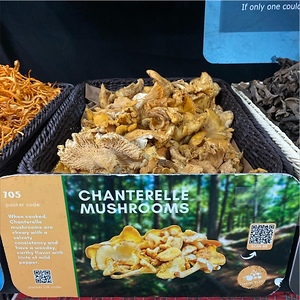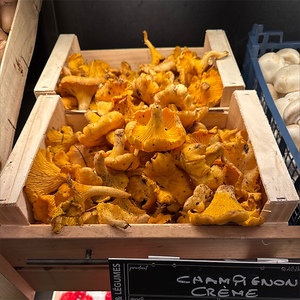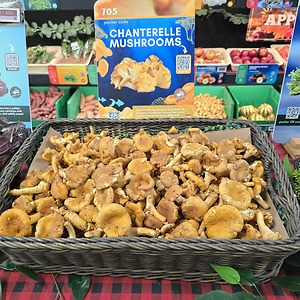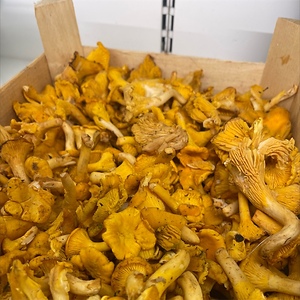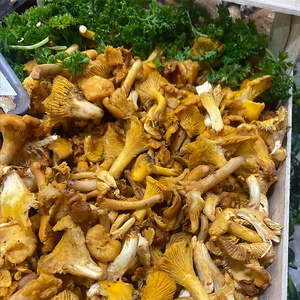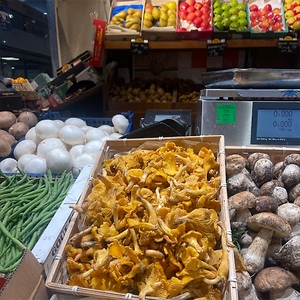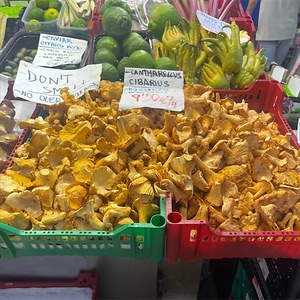


Chanterelle Mushrooms
Estimated Inventory, lb : 40.35
This item was last sold on : 07/17/25
Description/Taste
Chanterelle mushrooms vary in size and shape, depending on growing conditions and the individual species, but are typically harvested when their caps have reached 5 to 20 centimeters in diameter. Each Chanterelle mushroom has a distinct, funnel-like shape with a convex top, slender stem, and a central depression in the cap. The cap's edges are wavy, thick, and blunt, and the top is smooth and delicate. Chanterelle mushrooms are primarily found in shades of orange and yellow, but some species also showcase salmon, white, blue, and black-brown hues. Underneath the cap, the mushrooms lack true gills and bear shallow ridges extending down the stem. Chanterelle mushrooms produce yellow to cream-colored spores, and the stems are tapered and fleshy, ranging from 5 to 15 centimeters in length. When sliced in half, the flesh has a white hue and a springy consistency. Chanterelle mushrooms are known for their earthy and fruity aroma with apricot, cinnamon, and pepper-like undertones. When cooked, the mushrooms have a chewy and tender consistency and bear a woodsy, earthy, subtly sweet, nutty, peppery, and rich taste.
Seasons/Availability
Chanterelle mushrooms are available in the summer through early winter.
Current Facts
Chanterelle mushroom, botanically part of the Cantharellaceae family, is a general descriptor for multiple species of edible fungi foraged for culinary use. The name Chanterelle is a globally recognized term, and there are approximately ninety species of Chanterelle mushrooms worldwide. The Golden Chanterelle, or Cantharellus cibarius, is the most common variety in Europe and is treasured as a seasonal delicacy for its apricot-like aroma and nutty, peppery flavor. Outside of Europe, the term Golden Chanterelle is also used for several Cantharellus species in North America. Chanterelle mushrooms are a seasonally anticipated foraged ingredient and have remained primarily wild, as the fungi are challenging to produce commercially. Efforts are being made to cultivate the mushrooms for increased availability, but Chanterelle mushrooms require a delicate balance of nutrient-rich soil and ideal climatic conditions to properly grow, limiting development. Throughout history, Chanterelle mushrooms have symbolized wealth and luxury due to their distinct flavor and past reputation as a mushroom of nobility. This regal status has continued into the modern-day, as the fungi are still sold in commercial markets as a premium variety. Chanterelle mushrooms are favored by chefs and home cooks as a versatile mushroom incorporated into rich and savory culinary dishes.
Nutritional Value
Chanterelle mushrooms are a valued culinary ingredient with nutritional benefits to boost overall health and wellness. The vitamin and mineral content will vary, depending on the specific species of Chanterelle, but in general, the mushrooms are a source of calcium and phosphorus, which help the body support bones and teeth, iron to develop the protein hemoglobin for oxygen transport through the bloodstream, and potassium to balance fluid levels within the body. Mushrooms also provide copper to assist in the production of red blood cells, manganese to develop connective tissues, and fiber to regulate the digestive tract. In addition to various minerals, mushrooms contain vitamins A, C, and D and other antibacterial, antiviral, and antioxidant properties. Foraging for Chanterelle mushrooms should never be conducted without the help of an expert or medical professional to adequately identify the variety to ensure it is safe. There are two potentially poisonous look-a-likes to Chanterelle mushrooms, known as Jack-O-Lantern mushrooms, Omphalotus olearius, and False Chanterelle mushrooms, Hygrophoropsis aurantiaca.
Applications
Chanterelle mushrooms have a rich, subtly fruity, nutty, and savory taste suited for cooked culinary preparations. The mushrooms shine when incorporated into dishes with rich but mild flavored ingredients, allowing the Chanterelle’s delicate taste to become one of the focal flavors. Chanterelle mushrooms are popularly cooked in cream-based sauces, wine, or butter. The mushrooms are commonly roasted or sauteed as a simple side dish, and it is recommended to dry cook them in a pan before adding other ingredients to allow moisture to be released. When searching for Chanterelle recipes, the top dishes noted worldwide include using the mushrooms in pasta and risotto or cooking them into egg-based preparations like quiche and omelets. In the United States, Chanterelle mushrooms are often cooked into soups, stews, and rice or served as an accompaniment to roasted meat main dishes. Similar preparations have also been created in Europe, and mushrooms are often the seasonal star ingredient in summer and fall. In France, Chanterelle mushrooms are notably served in coquilles saint-jacques aux girolles, a dish of scallops and mushrooms. Chanterelle mushrooms are also used in cassoulet d'escargots aux girolles à la crème de persillade, a snail casserole with mushrooms. Chanterelle mushrooms pair well with herbs such as parsley, marjoram, thyme, sage, and tarragon and aromatics including garlic, shallots, and onions. Whole, unwashed, and uncooked Chanterelle mushrooms will keep for 1 to 2 weeks when stored in a container in the refrigerator. The mushrooms can also be dried or frozen for extended use.
Ethnic/Cultural Info
Golden Chanterelle mushrooms are known as the “gold of the forest” in Sweden and are one of the most popular seasonally foraged mushrooms. In Sweden, Chanterelle mushrooms are called Kantareller, and the mushroom’s fame across the country is attributed to the foundations created by French Marshal Jean-Baptiste Jules Bernadotte, later known as King Karl XIV Johan. Before the king’s ascension to the throne, wild mushrooms were rarely foraged as a culinary ingredient in Sweden. Jean-Baptist Bernadotte was elected Crown Prince of Sweden in 1810, and during his reign, he promoted the cultivation and foraging of mushrooms, a favored culinary ingredient used in his home country of France. Bernadotte also introduced French-derived mushroom recipes into Sweden in hopes of increasing the use of fungi in Swedish cuisine. Later in the 1900s, the Swedish upper class began spending time in nature as a leisurely activity and became fond of foraging for mushrooms, mainly Golden Chanterelles, as they were easy to identify. This encouraged the rise of mushrooms within Sweden, and by the 1930s and 1940s, mushrooms were widely accepted across all social classes. In the modern day, Sweden practices Allemansrätten or the “Right of Public Access.” This principle allows open land, forests, and other natural regions in Sweden to be available and accessed by the public, and mushroom foraging is included in this practice. Each summer and fall, Golden Chanterelle mushrooms are harvested from wild populations and are traditionally cooked and served over svamptoast, a famous snack in Sweden. Svamptoast is customarily made from sauteed Chanterelle mushrooms cooked in a mixture of butter, onions, lemon juice, and fresh herbs. This savory combination is served over toast and is occasionally topped with lingonberries as a seasonal dish.
Geography/History
Chanterelle mushrooms have origins in Europe, North America, Asia, and Africa and have been growing wild since ancient times. The mushrooms thrive on moist, shaded floors of temperate forests and are often found at the base of conifer and hardwood trees. Chanterelle mushrooms have historically fluctuated in culinary use throughout civilizations. They were consumed among some indigenous populations worldwide, especially in North America and Europe, but they also experienced periods of resistance, seen as a dangerous ingredient or as an animal feed. Later in the 16th century, mushrooms were declared a delicacy among the upper class in Europe and were first recorded in written recipes, establishing fungi as a choice ingredient. Over time, Chanterelle mushrooms were adopted into a wide array of cuisines, and select species were introduced and naturalized into Australia, Central America, and South America, expanding Chanterelle’s dominance as a global cultivar. Today, Chanterelle mushrooms are seasonally sold fresh through local markets, select retailers, and wholesalers worldwide. They are also dried and packaged through online retailers as a culinary good for chefs.
Featured Restaurants
Restaurants currently purchasing this product as an ingredient for their menu.
| Tribute Pizza | San Diego CA | 858-220-0030 |
| The Santaluz Club Inc - Main Dining | San Diego CA | 858-759-3150 |
| The Remy | San Diego CA | 619-886-1358 |
| Kettner Exchange | San Diego CA | 909-915-9877 |
| The Santaluz Club Inc - Banquet | San Diego CA | 858-759-3150 |
| Merenda | Oceanside CA | 703-459-4145 |
| Pacific Yacht Agents | Los Angeles CA | 808-214-0970 |
| Royal Polaris Sportfishing | San Diego CA | 619-226-8030 |
| Miho | San Diego CA | 619-365-5655 |
| Cal A Vie | Vista CA | 760-945-2055 |
| Catania La Jolla | La Jolla CA | 619-884-5350 |
| Herb & Wood | San Diego CA | 520-205-1288 |
| Le Coq | La Jolla CA | 858-427-1500 |
| Born & Raised | San Diego CA | 619-944-1631 |
| Bridges at Rancho Santa Fe | Rancho Santa Fe CA | 858-759-6063 |
| Make Stuff Good | San Diego CA | 949-547-9470 |
| C 2 C | San Diego CA | 619-972-9345 |
| Park Hyatt Aviara (Ember & Rye) | Carlsbad CA | 760-448-1234 |
| US Grant Hotel Grill | San Diego CA | 619-232-3121 |
| The Seabird Resort | Oceanside CA | 442-222-9505 |
| Kingfisher | San Diego CA | 619-861-8074 |
| Georges at the Cove | San Diego CA | 858-454-4244 |
| Golden Door | San Marcos CA | 760-761-4142 |
| Valley View Casino & Hotel (Black&Blue) | Valley Center CA | 760-291-5500 |
| InterContinental Vistal Kitchen | San Diego CA | 619-501-9400 |
| Chef Sebastian LLC | La Jolla CA | 858-740-0878 |
| Fairmont Grand Del Mar | San Diego CA | 858-314-1975 |
| Four Seasons Residence Club | Carlsbad CA | 760-603-6360 |
| 31ThirtyOne by Deckman | San Diego CA | 619-495-9814 |
| Lodge at Torrey Pines Main | San Diego CA | 858-453-4420 |
| Paradisaea Restaurant | La Jolla CA | 732-915-6669 |
Recipe Ideas
Recipes that include Chanterelle Mushrooms. One
Podcast







